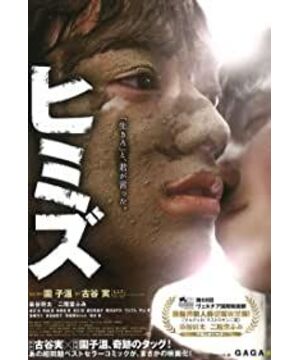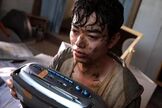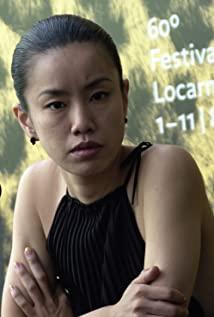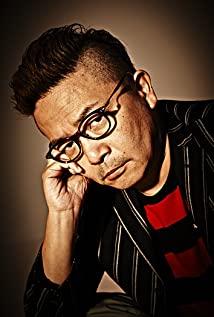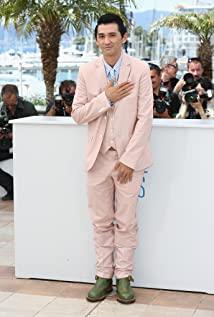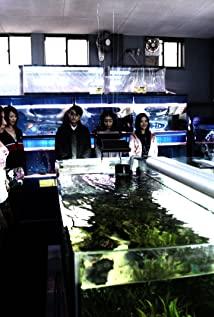"Mediocre" is adapted from the manga of the same name by the Japanese character cartoonist Furuya Mi, and the director is Sono Ziwen. Although the theme of despair in the original comics is very similar to the style of Yuan Ziwen's previous works, in the creation of this film, Yuan Ziwen did not completely black out, but adapted it to a large extent.
This change has a lot to do with the occurrence of the 3.11 earthquake. Before the earthquake, Yuan Ziwen had the idea of adapting the comics, but the setting of the story background and theme will not be too different from the original. But the sudden disaster suddenly woke him up and made him re-deconstruct the original work, thus achieving this movie "Mediocre", which is much brighter than the comics.
"Mediocre" tells the life of a certain group of people after the earthquake. Among them, the 15-year-old Sumita and his mother, as well as Yono, Tamura and others live in their own boat rental yard, but the constant harassment and violence of the excessive gambling father and the underworld make the Sumita's heart was extremely desperate, and on a rainy night, he committed an unforgivable crime. He thought that he could only go towards self-destruction in the end, but Chazawa, the female classmate who broke into Suita's life on his own, ended up running towards hope together with Suida in a special way.
The plot of this film is similar to that of the comics, but the change in the theme has led to a great change in the conveyed content. This article starts with the narrative technique and many symbolic meanings to analyze the profound theme conveyed by this film as the word mediocrity. .
Narrative technique: In the context of a major earthquake, a destructive life is used to tell the extraordinary of ordinary people
In fact, the life of ordinary people may not always be easy to achieve. The back of this film is set after a major earthquake. Many people's lives have suffered a major blow because of the earthquake. They were originally ordinary people, but because of this disaster, even ordinary people have become luxury.
But in the film, what is unusual is not just the people after the disaster, but more importantly, a group of people who are struggling to survive under the double blow of their families. In the background of despair, Sono Ziwen joined a destructive life, which implied the transmission of the theme of the film everywhere.
①Sumita's destructive family and its destructive behavior
At first, Sumita lived with his mother in a boat rental yard, but because of a father who gambled heavily, not only did he owe usurious loans, but he also came back to find Sumita from time to time for trouble, including sarcasm and violent beatings.
After that, his mother who lived with Sumita also abandoned him and went away. What followed was violent debt collection by the triad. Naturally, Sumita could not solve it, and could only endure their beatings.
Sumita's family can be said to be destructive, not only has a series of troubles, not the love of his parents, but his father also made it clear that he regrets giving birth to Sumita. It was not the blow of life that made Sumita lose hope completely, but the abandonment of his relatives and the stimulation of cold words.
Therefore, the destructive family made him do a destructive thing, that is, on a rainy night, he ended his father's life on impulse, and let him start a real road of no return.
Sonoko Wen always digs deep themes in the movies, and this picture of death and violence is just like his style as always. The more cruel a person's life is, the farther the ordinary life is set off, and it is so difficult to become a mediocrity.
②The helpless survival of ordinary people
In addition to Sumita, who is highlighted in the film, Yuan Ziwen also set up more similar character identities and situations.
For example, Chazawa, the only female classmate who admired Sumita, broke into Sumita's life in a very weird way at first. Whether it was her behavior or what she said, it would inevitably make people feel a little nervous.
Especially the sentence "Ordinary is the best" that Sumita said in class, she almost wanted to raise her hands to agree. This seemingly abnormal girl, with the development of the plot, the audience's eyes are getting softer and softer, and more reasons may lie in her family.
The girl Chazawa is also a person who suffered family misfortune. Her mother even made a torture tool for her, hoping that her daughter would not stay in this world, and she imagined that if her daughter left, she could live happily with Chazawa's father forever.
Many people may not be able to understand such behavior and imagine that there are such parents, but Sono Ziwen deliberately added this scene when shooting, but there are prototypes in life.
In addition, there are bloody scenes of moral kidnapping by bus, and weird women with scantily clad clothes and iron chains tied to their feet. These people living in the same world may be experiencing things that outsiders cannot understand.
Just like the countless individuals in the film, in life, there are very few people who can understand them, maybe almost none. There are things in this world that are more helpless than ordinary. Under the strange appearance of everyone, there may be a heart that longs for ordinary.
Symbolism: Imaginative material, interwoven with themes of failure and hope
Sono Ziwen uses a lot of "tools" in the film, and almost everything is not set arbitrarily, but based on ingenious arrangements. The meanings of these "tools" all have certain metaphors in addition to their necessary functions.
①The dilapidated hut floating in the center of the lake
This dilapidated hut above the water lasts almost from the beginning to the end of the film. Why does the director take such pleasure in presenting this hut in front of the audience? In my opinion, this cabin is not the same in the beginning and the end, but it is the thematic thread of the film.
In the destructive situation presented in the early stage, the camera repeatedly turned to this hut submerged in water, which is precisely the representative of destructive. Before this, some people may have lived in the hut, but because of the disaster, they sank in the lake, and now they can only watch it from a distance. This is very similar to what happened to the protagonist of the film, Sumita. Sumita is like a hut that is about to sink to the bottom of a lake. He is struggling. With a little more force, he can be pushed into a desperate situation and completely submerged in the water.
But in the later period, this hut was given a new meaning. Although it has been submerged in the lake, as long as it is still exposed, it is a symbol of hope.
This hope is more like the girl Chazawa, who made the right choice for Sumita when he lost the meaning of life, thus leading him to the path of hope.
In the film, this hut has no language, but the silence is better than the sound. We spy the truth under its lonely appearance, and hope that it will be more vividly presented in front of us.
②Bricks, knives, guns
Although the background color of the film is bright, there are still many dark elements on the surface, such as the brick that Sumita committed a crime at first, the knife that ran all over the street later, and the gun that someone gave him in the end.
However, although these items have elements of violence, the meanings they contain are not the same. These three items seem to be more lethal than the other, but in the film, the lethality is constantly weakening.
Among them, the brick is the most lethal one, because Sumita committed a crime with it. The brick is not only a struggle with the family, but also the end of destruction. Later, Sumita used the time he thought he had earned to take out the bad guys and make a contribution to the society with a knife, but in every accident, he failed to do so. On the contrary, in the process, he felt the warmth of some people towards him. In the end, it was the robbery. Sumita once dreamed that he committed suicide with the gun, but at the end of the movie, although the robbery rang, it did not bring death, but hope.
Sonoko uses these dark elements to present us a slightly depressing world, but uses these symbols of violence to complete the reversal from darkness to light.
③The poems and slogans of the girl Chazawa
At the beginning of the film, Cha Ze has a monologue: "I know it all, flies fall into the milk, black and white are clear at a glance, and I know it. I know my identity by the clothes, and I know it; the weather is good or bad, I know it; I can recognize it when I see an apple tree. Apple, I also know this; the diligent and the lazy can see at a glance, everything is clear to me, except myself. In short, I know it. There is a big difference between a healthy face and a pale face, and I also know that ; death brings an end to all things, and everything is known to the heart, except itself."
Sumita has also read this passage. It is worth pondering that they seem to understand everything, but they only don’t understand themselves. Is this a mediocrity?
In addition, when Chazawa printed a flyer for Sumita's boat rental yard, he wrote: "How about choosing this place as the last stop on a date? You don't have to travel far to go fishing, stay away from the hustle and bustle of the city, relax and enjoy fishing."
When she came home and saw the torture instruments her parents had prepared for her, she kept repeating these words in her room, almost collapsed and desperate. In her hoarse cry, behind these ordinary words, became her all hope for life.
Sono Ziwen never wastes every detail of his settings, makes the best use of everything, and conveys the theme he wants to express to the greatest extent, which is the biggest feature of his films.
Movie theme: Some people spend their whole lives just wanting to be a "mediocre"
The original meaning of mediocrity refers to people with mediocre and inferior talents, but this film has made a new definition for mediocrity. The mediocrity is not only the hope in a desperate life, but also the yearning for the ordinary life. The final definition of mediocrity is to become an ordinary person. people.
In Sumita's experience, if there is no desperate family, he may not be able to go to the step of destruction, but under the circumstance that he cannot escape from his birth, if it is not for the help of the people around him, he will not be able to go to redemption. Therefore, with multiple assistances, the film opens up a path for the protagonist to become a "mediocre talent".
①Good nature and only remaining hope
The protagonist in the film has experienced the unfair treatment brought by the world, but he has not lost his good nature. Sumita collapsed after taking the life of his beastly father, and when he came to his senses, he held a knife and wanted to contribute to society with his "bonded life". The last few people were rescued because of him, but when he tried to stab the bad guy, they were all stopped. This knife is not only not destruction, but also has a taste of redemption, and it is the display of Sumita's kind nature.
Secondly, we often see Sumita and Chazawa weeping together. I believe that the tears are not despair, but because there is some kind of hope.
At the end of the film, Chazawa, the girl who walked into Sumita's heart, described to Sumita about the day she dreamed of the two of them. The dream was ordinary, but it was infinitely yearning.
It is under the good nature and the remaining hope that Sumita finally leads the way to save himself. They shouted cheers, ran towards hope, and ran towards the ordinary life of their dreams.
②The deepest tenderness given by a friend
What we cannot ignore from time to time is that there are some other people living in the boat rental yard of Sumita. Although those people can only live in a tent and have limited ability, as friends of Sumita, they have never been disappointed.
When Sumita encountered something unhappy, they worked together to decorate Sumita's home and let him change his mood; Sumita committed an unforgivable crime that rainy night, and broke down and cried, and they silently held their hearts in the tent. , couldn't bear to let the most embarrassing scene be broken; when Sumita was beaten by the triad because of the debt owed by his father, the old man named Ye Ye risked his life to raise money for Sumita to repay.
This is the only warmth of a junior high school student who is lonely, abandoned by his parents and under the pressure of society.
As Yono said, he is old, but Sumita is still young, and he still has a future, so they are willing to exchange what they have in exchange for Sumita's future.
In the film presented by Yuan Ziwen, the broken family is the root of all evil, but there is a deep tenderness hidden in the dark night of despair. This tenderness seems to be a pair of hands, pulling back Sumita, who is about to be destroyed.
Because the bright ending of this work is not very similar to Yuan Ziwen's previous works, to a certain extent, some people are inevitably disappointed. But I believe that Yuan Ziwen has light in his heart. When the big earthquake comes, people have suffered enough despair. Standing under the ruins, if no seeds of hope break out, what will be waiting for people will be what is it then?
Therefore, although this "Mediocre Talent" has despair, it finally ends in a bright light. The boy Sumita turns himself in, and the girl Cha Ze shouts to cheer on the side. This is not only what he said to Sumita, but also to everyone in despair. if.
The desire of these people is so humble that they only want to be a "mediocre" for the rest of their lives.
View more about Themis reviews


